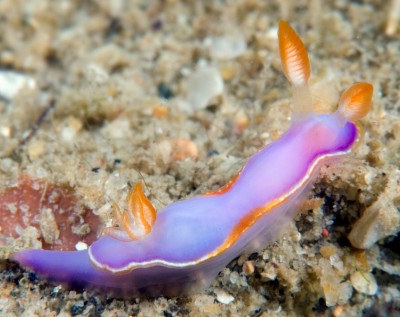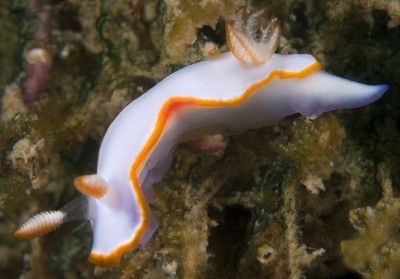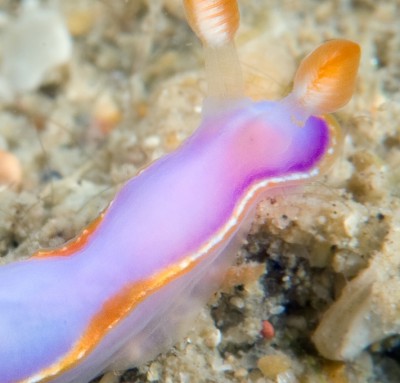Thorunna horologia from the Andaman Sea
April 19, 2010
From: Lawrence Neal


Concerning message #23489:
Dear Bill,
Following on from Vishal Bhave's message recording Thorunna africana from the Andaman Islands, here are records of another species - which I think is Thorunna horologia - from the Andaman coast of Thailand.
I have never yet seen this species in the heavily dived offshore Similan Islands, but it is locally common in shallow rocky areas (less than 10 metres deep) close to the coast. The body colour seems to exhibit a range of colour from more or less all purple to purple-white to all white, with white being the commonest. I feel that they are all the same species. Perhaps the purplish ones are juveniles?
This species is a bit bigger and more robust than Thorunna florens which is also locally common here in the same environments.
Locality: Tablamu, 6 metres, Phangnga, Thailand, Andaman Sea, Indian Ocean, Rocky shoreline. Length: 12 mm. Upper photo: 28 February 2010, Size 10 mm; Lower photo: 26 February 2010, Size 12 mm. Photographer: Lawrence Neal.
Best regards,
Lawrence
lorenzo_n@yahoo.com
Neal, L., 2010 (Apr 19) Thorunna horologia from the Andaman Sea. [Message in] Sea Slug Forum. Australian Museum, Sydney. Available from http://www.seaslugforum.net/find/23500
Dear Lawrence,
It would need a look at the anatomy to be safe, but from your description of colout varaition from white to purple, I would agree that this is T. horologia. Certainly the orange 'waist' on each side of the mantle link your animals with those of the western Indian Ocean. In Indo-Pacific Nudibranchs your animal is considered a species distinct from T. horologia but I suspect that is an unnecessary move. They have records from the Philippines and Indonesia so if it is T. horologia, it increases its range right across the Indian Ocean.
I have included a close-up alongside to show the small white glands which run along the edge of the mantle. These glands contain distasteful chemcials from the sponges they eat and the shape and arrangement of these glands differ within the chromodorids. They are sometimes difficult to see in species of Thorunna so this is a educational photo.
Best wishes,
Bill Rudman
Related messages
-
Thorunna horologia and friends?
From: Valda Fraser, February 16, 2009 -
Re: Thorunna horologia from Reunion island
From: Sully Bachel, February 6, 2009 -
Thorunna horologia from Reunion island
From: Philibert Bidgrain, June 17, 2005 -
Thorunna horologia from Sodwana Bay
From: Colin Ogden, June 9, 2005 -
Thorunna horologia from South Africa
From: Valda Fraser, April 18, 2000 -
Thorunna horologica in South Africa
From: Terry Gosliner, November 18, 1998
